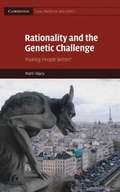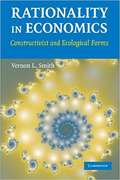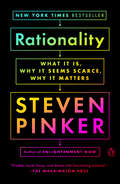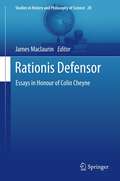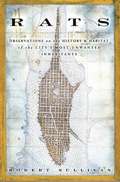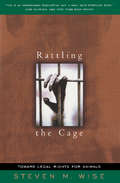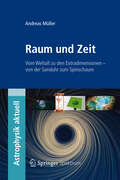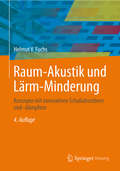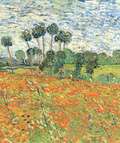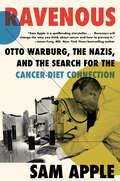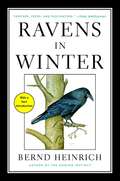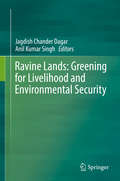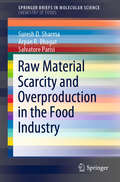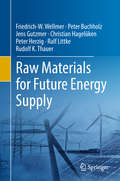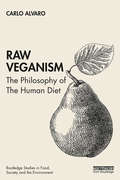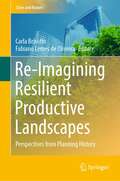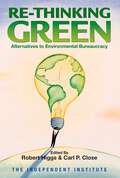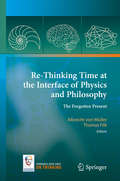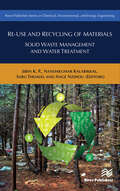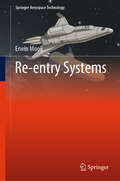- Table View
- List View
Rationality and the Genetic Challenge
by Matti HäyryShould we make people healthier, smarter, and longer-lived if genetic and medical advances enable us to do so? Matti Häyry asks this question in the context of genetic testing and selection, cloning and stem cell research, gene therapies and enhancements. The ethical questions explored include parental responsibility, the use of people as means, the role of hope and fear in risk assessment, and the dignity and meaning of life. Taking as a starting point the arguments presented by Jonathan Glover, John Harris, Ronald M. Green, Jurgen Habermas, Michael J. Sandel, and Leon R. Kass, who defend a particular normative view as the only rational or moral answer, Matti Häyry argues that many coherent rationalities and moralities exist in the field, and that to claim otherwise is mistaken.
Rationality and the Genetic Challenge: Making People Better?
by Matti HäyryShould we make people healthier, smarter, and longer-lived if genetic and medical advances enable us to do so? Matti Häyry asks this question in the context of genetic testing and selection, cloning and stem cell research, gene therapies and enhancements. The ethical questions explored include parental responsibility, the use of people as means, the role of hope and fear in risk assessment, and the dignity and meaning of life. Taking as a starting point the arguments presented by Jonathan Glover, John Harris, Ronald M. Green, Jürgen Habermas, Michael J. Sandel, and Leon R. Kass, who defend a particular normative view as the only rational or moral answer, Matti Häyry argues that many coherent rationalities and moralities exist in the field, and that to claim otherwise is mistaken.
Rationality in Economics
by Vernon L. SmithThe principal findings of experimental economics are that impersonal exchange in markets converges in repeated interaction to the equilibrium states implied by economic theory, under information conditions far weaker than specified in the theory. In personal, social, and economic exchange, as studied in two-person games, cooperation exceeds the prediction of traditional game theory. This book relates these two findings to field studies and applications and integrates them with the main themes of the Scottish Enlightenment and with the thoughts of F. A. Hayek: through emergent socio-economic institutions and cultural norms, people achieve ends that are unintended and poorly understood. In cultural changes, the role of constructivism, or reason, is to provide variation, and the role of ecological processes is to select the norms and institutions that serve the fitness needs of societies.
Rationality: What It Is, Why It Seems Scarce, Why It Matters
by Steven PinkerCan reading a book make you more rational? Can it help us understand why there is so much irrationality in the world? Steven Pinker, author of Enlightenment Now (Bill Gates’s "new favorite book of all time”) answers all the questions here. <p><p> Today humanity is reaching new heights of scientific understanding--and also appears to be losing its mind. How can a species that developed vaccines for Covid-19 in less than a year produce so much fake news, medical quackery, and conspiracy theorizing? Pinker rejects the cynical cliché that humans are simply irrational--cavemen out of time saddled with biases, fallacies, and illusions. After all, we discovered the laws of nature, lengthened and enriched our lives, and set out the benchmarks for rationality itself. <p><p> We actually think in ways that are sensible in the low-tech contexts in which we spend most of our lives, but fail to take advantage of the powerful tools of reasoning we’ve discovered over the millennia: logic, critical thinking, probability, correlation and causation, and optimal ways to update beliefs and commit to choices individually and with others. These tools are not a standard part of our education, and have never been presented clearly and entertainingly in a single book--until now. <p><p> Rationality also explores its opposite: how the rational pursuit of self-interest, sectarian solidarity, and uplifting mythology can add up to crippling irrationality in a society. Collective rationality depends on norms that are explicitly designed to promote objectivity and truth. Rationality matters. It leads to better choices in our lives and in the public sphere, and is the ultimate driver of social justice and moral progress. Brimming with Pinker’s customary insight and humor, Rationality will enlighten, inspire, and empower.
Rationis Defensor
by James MaclaurinRationis Defensor is to be a volume of previously unpublished essays celebrating the life and work of Colin Cheyne. Colin was until recently Head of the Department of Philosophy at the University of Otago, a department that can boast of many famous philosophers among its past and present faculty and which has twice been judged as the strongest research department across all disciplines in governmental research assessments. Colin is the immediate past President of the Australasian Association for Philosophy (New Zealand Division). He is the author of Knowledge, Cause, and Abstract Objects: Causal Objections to Platonism (Springer, 2001) and the editor, with Vladimir Svoboda and Bjorn Jespersen, of Pavel Tichy's Collected Papers in Logic and Philosophy (University of Otago Press, 2005) and, with John Worrall, of Rationality and Reality: Conversations with Alan Musgrave (Springer, 2006). This volume celebrates the dedication to rational enquiry and the philosophical style of Colin Cheyne. It also celebrates the distinctive brand of naturalistic philosophy for which Otago has become known. Contributors to the volume include a wide variety of philosophers, all with a personal connection to Colin, and all of whom are, in their own way, defenders of rationality.
Rats: Observations on the History and Habitat of the City's Most Unwanted Inhabitants
by Robert C. SullivanBeginning in the summer of 2001, the author spent night after night observing rats as they foraged in a New York City alley. In addition to gathering information on the behavior of these ubiquitous and seemingly indestructible rodents, he delves into the long and complex history of rat/human relations. Topics include Victorian-era rat-fighting (in which dogs were pitted against packs of rats), exterminators and their lore, and the history of the Black Death in Europe and the United States. The theme of this book could be summed as as "Rats R Us."
Rattler (Penguin Core Concepts Ser.)
by Mary BattenSlither along with one of nature's deadliest hunters—and learn all about what makes rattlesnakes so dangerous!Rattler has not eaten in a week. After hiding from the hot sun all day, he starts hunting. Rattler uses his venom to paralyze his prey and his tail to scare away predators. He even swallows his prey whole! Follow along as Rattler grows up, sheds his skin, and has his own children.
Rattling The Cage
by Steven Wise Introduction by Jane GoodRattling the Cage explains how the failure to recognize the basic legal rights of chimpanzees and bonobos in light of modern scientific findings creates a glaring contradiction in our law. In this witty, moving, persuasive, and impeccably researched argument, Wise demonstrates that the cognitive, emotional, and social capacities of these apes entitle them to freedom from imprisonment and abuse.
Raum und Zeit
by Andreas MüllerRaum und Zeit sind die große Bühne, auf der sich unser Leben und alle irdischen und kosmischen Vorgänge abspielen. Meist erleben wir Raum und Zeit als unveränderlich und unbeeinflussbar. Doch Raum und Zeit könnten Eigenschaften haben, von denen selbst Einstein nicht zu träumen wagte. Andreas Müller erläutert unser modernes und höchst faszinierendes naturwissenschaftliches Weltbild und stellt das erfolgreiche Konzept der Raumzeit vor, das vor gut hundert Jahren von Albert Einstein begründet wurde. Darüber hinaus führt er den Leser bis zu den spannendsten Fragen der Gegenwart: Gibt es mehr als drei Raumdimensionen? Sind Raum und Zeit grundsätzlich in endliche, minimale Stücke zerhackt? Werden Raum und Zeit ewig existieren? Und welche Schlussfolgerungen über die Natur von Raum und Zeit müssen wir vor dem Hintergrund moderner Forschung ziehen?
Raum und Zeit: Vom Weltall zu den Extradimensionen - von der Sanduhr zum Spinschaum (Astrophysik aktuell)
by Andreas MüllerRaum und Zeit sind die große Bühne, auf der sich unser Leben und alle irdischen und kosmischen Vorgänge abspielen. Meist erleben wir Raum und Zeit als unveränderlich und unbeeinflussbar. Doch Raum und Zeit könnten Eigenschaften haben, von denen selbst Einstein nicht zu träumen wagte. Andreas Müller erläutert unser modernes und höchst faszinierendes naturwissenschaftliches Weltbild und stellt das erfolgreiche Konzept der Raumzeit vor, das vor gut hundert Jahren von Albert Einstein begründet wurde. Darüber hinaus führt er den Leser bis zu den spannendsten Fragen der Gegenwart: Gibt es mehr als drei Raumdimensionen? Sind Raum und Zeit grundsätzlich in endliche, minimale Stücke zerhackt? Werden Raum und Zeit ewig existieren? Und welche Schlussfolgerungen über die Natur von Raum und Zeit müssen wir vor dem Hintergrund moderner Forschung ziehen?
Raum-Akustik und Lärm-Minderung: Konzepte mit innovativen Schallabsorbern und -dämpfern (VDI-Buch)
by Helmut V. FuchsDie 4. Auflage dieses inzwischen als Standardwerk anerkannten Fachbuchs greift wieder aktuelle Probleme bei der Gestaltung von Raum-Akustik, Freifeld-Pr#65533;fst#65533;nden und Kanal-Auskleidungen auf. Zu deren nachhaltiger L#65533;sung werden Materialien und Bauteile sowie Auslegungskonzepte nach neuestem Stand des Wissens allgemein verst#65533;ndlich dargestellt. Aufbauend auf den Grundlagen wird das Konzept vertieft. Mehr als 100 Fallbeispiele zeigen, welche konstruktiven und baulichen Ma#65533;nahmen schnell und kosteng#65533;nstig zum Ziel f#65533;hren k#65533;nnen. Akustiker in der Praxis und Forschung sowie entwerfende und planende Architekten, Bauingenieure und Haustechniker finden neben den Grundlagen und Konzepten besonders auf f#65533;r bisher vernachl#65533;ssigten Bereich der tiefen Frequenzen wichtige Hinweise. In Darstellung und L#65533;sung akuter schalltechnischer Probleme stellt der Autor auch neue Erkenntnisse und Konzepte zur Verf#65533;gung, bei denen stets das praktisch N#65533;tzliche im Vordergrund steht. F#65533;r die eingef#65533;hrten Normen werden Probleml#65533;sungen ebenso behandelt wie die Grenzen der Anwendung, wo weiterf#65533;hrende L#65533;sungen gesucht werden. F#65533;r L#65533;rmprobleme in Arbeits- und Freizeit-R#65533;umen liefert das Buch eine F#65533;lle konstruktiver Anregungen.
Raven Biology of Plants (Eighth Edition)
by Ray F. Evert Susan E. EichhornLong acclaimed as the definitive introductory botany text, Raven Biology of Plants, Eighth Edition by Ray Evert, Susan Eichhorn, stands as the most significant revision in the book’s history. Every topic was updated with information obtained from the most recent primary literature, making the book valuable for both students and professionals
Ravenous: Otto Warburg, The Nazis, And The Search For The Cancer-diet Connection
by Sam AppleThe extraordinary story of the Nazi-era scientific genius who discovered how cancer cells eat—and what it means for how we should. The Nobel laureate Otto Warburg—a cousin of the famous finance Warburgs—was widely regarded in his day as one of the most important biochemists of the twentieth century, a man whose research was integral to humanity’s understanding of cancer. He was also among the most despised figures in Nazi Germany. As a Jewish homosexual living openly with his male partner, Warburg represented all that the Third Reich abhorred. Yet Hitler and his top advisors dreaded cancer, and protected Warburg in the hope that he could cure it. In Ravenous, Sam Apple reclaims Otto Warburg as a forgotten, morally compromised genius who pursued cancer single-mindedly even as Europe disintegrated around him. While the vast majority of Jewish scientists fled Germany in the anxious years leading up to World War II, Warburg remained in Berlin, working under the watchful eye of the dictatorship. With the Nazis goose-stepping their way across Europe, systematically rounding up and murdering millions of Jews, Warburg awoke each morning in an elegant, antiques-filled home and rode horses with his partner, Jacob Heiss, before delving into his research at the Kaiser Wilhelm Society. Hitler and other Nazi leaders, Apple shows, were deeply troubled by skyrocketing cancer rates across the Western world, viewing cancer as an existential threat akin to Judaism or homosexuality. Ironically, they viewed Warburg as Germany’s best chance of survival. Setting Warburg’s work against an absorbing history of cancer science, Apple follows him as he arrives at his central belief that cancer is a problem of metabolism. Though Warburg’s metabolic approach to cancer was considered groundbreaking, his work was soon eclipsed in the early postwar era, after the discovery of the structure of DNA set off a search for the genetic origins of cancer. Remarkably, Warburg’s theory has undergone a resurgence in our own time, as scientists have begun to investigate the dangers of sugar and the link between obesity and cancer, finding that the way we eat can influence how cancer cells take up nutrients and grow. Rooting his revelations in extensive archival research as well as dozens of interviews with today’s leading cancer authorities, Apple demonstrates how Warburg’s midcentury work may well hold the secret to why cancer became so common in the modern world and how we can reverse the trend. A tale of scientific discovery, personal peril, and the race to end a disastrous disease, Ravenous would be the stuff of the most inventive fiction were it not, in fact, true.
Ravens in Winter
by Bernd Heinrich"One of the most interesting discoveries I've seen in animal sociobiology in years." --E.O. WilsonWhy do ravens, generally understood to be solitary creatures, share food between each other during winter? On the surface, there didn't appear to be any biological or evolutionary imperative behind the raven's willingness to share. The more Bernd Heinrich observed their habits, the more odd the bird's behavior became. What started as mere curiosity turned into an impassioned research project, and Ravens In Winter, the first research of its kind, explores the fascinating biological puzzle of the raven's rather unconventional social habits. "Bernd Heinrich is no ordinary biologist. He's the sort who combines formidable scientific rigor with a sense of irony and an unslaked, boyish enthusiasm for his subject, and who even at his current professorial age seems to do a lot of tree climbing in the line of research." --David Quammen, The New York Timesroject, and Ravens In Winter, the first research of its kind, explores the fascinating biological puzzle of the raven's rather unconventional social habits.
Ravine Lands: Greening for Livelihood and Environmental Security
by Jagdish Chander Dagar Anil Kumar SinghThis book, the only one of its kind on ravine lands, reflects the significant advances made over the past two decades in our understanding of gully erosion, its controlling factors, and various aspects of gully erosion. It also addresses central research gaps and unanswered questions, which include historical studies on gully erosion to better understand the different stages of their formation; appropriate measuring techniques for monitoring or assessing the geological and hydrological parameters and processes involved in gully development; interaction of hydrological and other soil degradation processes; ecology and biodiversity of fragile ravines; impact of climate and environmental changes on soil erosion processes; development of effective and reliable gully erosion models; effective gully prevention and control measures; watershed-based management options; and ravine rehabilitation policies. The present book is a highly timely publication and deals with various aspects of ravine ecology and rehabilitation of degraded lands, particularly with the aid of biological approaches. As such, it offers a valuable guide for all scientists working in the fields of soil conservation / rehabilitation and agroforestry, students, environmentalists, educationists, and policymakers. More importantly, it focuses on the rehabilitation of one of the world’s most degraded and fragile ecosystems, ensuring the livelihoods of resource-poor farmers and landless families living in harsh ecologies that are more vulnerable to climate change.
Raw Material Scarcity and Overproduction in the Food Industry (SpringerBriefs in Molecular Science)
by Salvatore Parisi Suresh D. Sharma Arpan R. BhagatThis book describes the consequences of an increased demand for food for human consumption for the global food industry. In four concise chapters, the authors explore the trend for the overproduction of food, the concomitant diminution of raw materials and the increase in environmental concerns. Chapter one describes the variations in biochemical properties of fishmeal depending on the season and geographical location. Chapter two discusses how the expansion of cropland and pastures to meet the rising demand for food is damaging the environment, while chapter three examines the impact of bee viruses on food crops and production. Lastly, the fourth chapter addresses the issue of food adulteration and provides specific examples of fraud in the American dairy industry. This book is of interest to researchers working in the area of food production in academia and industry, as well as certification and scientific bodies involved in food inspection.
Raw Materials for Future Energy Supply
by Peter Buchholz Friedrich-W. Wellmer Jens Gutzmer Christian Hagelüken Peter Herzig Ralf Littke Rudolf K. ThauerThis is the first book that analyses the future raw materials supply from the demand side of a society that chiefly relies on renewable energies, which is of great significance for us all. It addresses primary and secondary resources and substitution, not only from technical but also socioeconomic and ethical points of view.The “Energiewende” (Energy Transition) will change our consumption of natural resources significantly. When in future our energy requirements will be covered mostly by wind, solar power and biomass, we will need less coal, oil and natural gas. However, the consumption of minerals, especially metallic resources, will increase to build wind generators, solar panels or energy storage facilities. Besides e.g. copper, nickel or cobalt, rare earth elements and other high-tech elements will be increasingly used. With regard to primary metals, Germany is 100 % import dependent; only secondary material is produced within Germany. Though sufficient geological primary resources exist worldwide, their availability on the market is crucial. The future supply of the market is dependent on the development of prices, the transparency of the market and the question of social and ethical standards in the raw materials industry, as well as the social license to operate, which especially applies to mining. The book offers a valuable resource for everyone interested in the future raw material supply of our way of life, which will involve more and more renewable energies.
Raw Veganism: The Philosophy of The Human Diet (Routledge Studies in Food, Society and the Environment)
by Carlo AlvaroHuman beings are getting fatter and sicker. As we question what we eat and why we eat it, this book argues that living well involves consuming a raw vegan diet. With eating healthfully and eating ethically being simpler said than done, this book argues that the best solution to health, environmental, and ethical problems concerning animals is raw veganism—the human diet. The human diet is what humans are naturally designed to eat, and that is, a raw vegan diet of fruit, tender leafy greens, and occasionally nuts and seeds. While veganism raises challenging questions over the ethics of consuming animal products, while also considering the environmental impact of the agriculture industry, raw veganism goes a step further and argues that consuming cooked food is also detrimental to our health and the environment. Cooking foods allows us to eat food that is not otherwise fit for human consumption and in an age that promotes eating foods in ‘moderation’ and having ‘balanced’ diets, this raises the question of why we are eating foods that should only be consumed in moderation at all, as moderation clearly implies they aren’t good for us. In addition, from an environmental perspective, the use of stoves, ovens and microwaves for cooking contributes significantly to energy consumption and cooking in general generates excessive waste of food and resources. Thus, this book maintains that living well and living a noble life, that is, good physical and moral health, requires consuming a raw vegan diet. Exploring the scientific and philosophical aspects of raw veganism, this novel book is essential reading for all interested in promoting ethical, healthful, and sustainable diets.
Ray Tracing and Beyond
by Aptara. Inc E. R. TracyThis complete introduction to the use of modern ray tracing techniques in plasma physics describes the powerful mathematical methods generally applicable to vector wave equations in non-uniform media, and clearly demonstrates the application of these methods to simplify and solve important problems in plasma wave theory. Key analytical concepts are carefully introduced as needed, encouraging the development of a visual intuition for the underlying methodology, with more advanced mathematical concepts succinctly explained in the appendices, and supporting Matlab and Raycon code available online. Covering variational principles, covariant formulations, caustics, tunnelling, mode conversion, weak dissipation, wave emission from coherent sources, incoherent wave fields, and collective wave absorption and emission, all within an accessible framework using standard plasma physics notation, this is an invaluable resource for graduate students and researchers in plasma physics.
Ray's Big Day: A Journey at the Speed of Light
by Josh LewisFollow one little ray of light as she embarks on an exciting journey through the solar system and beyond!When Ray launches from the sun into outer space, she knows she's destined for adventure. But who knew everything in space was so far apart? Can Ray unlock her creativity to pass the time and make something new?With a lovable protagonist and engaging comic illustrations, Ray's Big Day tackles the vastness of space through one ray of light's optimistic exploration. Ray's journey makes basic information about the solar system, the universe, and the speed of light accessible and engaging for kids. Fun and educational backmatter illustrates how far and fast light travels through our solar system.Perfect for readers of Stacy McAnulty's Earth! My First 4.54 Billion Years.
Re-Imagining Resilient Productive Landscapes: Perspectives from Planning History (Cities and Nature)
by Fabiano Lemes de Oliveira Carla BrisottoThis book explores how lessons from past urban planning experiences can inform current debates on urban agriculture. Productive landscapes today have been posited as instruments for the positive transformation related to territorial fragility and abandonment, promoting social cohesion, food security and wider environmental and economic benefits. The book will re-map the way in which seeming landscape limitations and challenges can be turned into potential, innovation and a new lease of urban-rural life. It does so by drawing on significant past urban agricultural experiences in planning as vectors for new critical reflections relevant to re-igniting ideas for future envisioning of urban scenarios in which productive landscapes play fundamental transformative roles. The focus is on planning ideas and the roles of key individual planners, all of which have designed agricultural strategies for the city at some point in their careers. It intends to help us today reimagine urban-rural relationships, and the transformation of under or mis-used urban open spaces, peri-urban areas, fringe conditions and in-between spaces.
Re-Thinking Green: Alternatives to Environmental Bureaucracy
by Robert HiggsEnvironmental quality has been a major public concern since the first Earth Day in 1970, yet the maze of environmental laws and regulations enacted since then has fostered huge government bureaucracies better known for waste and failure than for innovation and success.Can we do better than this failed environmental bureaucracy? The noted contributors to this volume answer with a resounding "yes." Re-Thinking Green exposes the myths that have contributed to failed environmental policies and proposes bold alternatives that recognize the power of incentives and the limitations of political and regulatory processes. It addresses some of the most hotly debated environmental issues and shows how entrepreneurship and property rights can be utilized to promote environmental quality and economic growth. Re-Thinking Green will challenge readers with new paradigms for resolving environmental problems, stimulate discussion on how best to "humanize" environmental policy, and inspire policymakers to seek effective alternatives to environmental bureaucracy.
Re-Thinking Time at the Interface of Physics and Philosophy
by Thomas Filk Albrecht MüllerThe current volume of the Parmenides Series "On Thinking" addresses our deepest and most personal experience of the world, the experience of "the present," from a modern perspective combining physics and philosophy. Many prominent researchers have contributed articles to the volume, in which they present models and express their opinions on and, in some cases, also their skepticism about the subject and how it may be (or may not be) addressed, as well as which aspects they consider most relevant in this context. While Einstein might have once hoped that "the present" would find its place in the theory of general relativity, in a later discussion with Carnap he expressed his disappointment that he was never able to achieve this goal. This collection of articles provides a unique overview of different modern approaches, representing not only a valuable summary for experts, but also a nearly inexhaustible source of profound and novel ideas for those who are simply interested in this question.
Re-Use and Recycling of Materials: Solid Waste Management and Water Treatment (River Publishers Series In Chemical, Environmental, And Energy Engineering Ser.)
by Sabu Thomas Nandakumar Kalarikkal Ange Nzihou Jibin K. P.In recent years, a considerable amount of effort has been devoted, both in industry and academia, towards the recycling and reuse of materials. Most nations are now trying to reduce the amount of waste materials, through the proper recycling of materials.Re-Use and Recycling of Materials will help readers to understand the current status in the field of waste management, as well as what research is taking place to deal with such issues.Technical topics discussed in the book include: Municipal solid waste management Recycling of WEEE Waste to industrially important product like lignin and cellulose Recycling of agriculture waste Polymer and plastic recycling
Re-entry Systems (Springer Aerospace Technology)
by Erwin MooijThis book explains and describes re-entry systems for both the Earth and other planets. It provides sufficient information for readers to perform entry mission analysis for different bodies in the Solar System. Not only does it discuss re-entry flight mechanics, but also addresses relevant subsystems and fields, enabling readers to put the information into perspective. The book begins with a complete description of planetary environments, including atmosphere, gravity fields and the shape of the primary body. After a detailed discussion of planar flight mechanics, it then moves on to discuss guidance, navigation, and control, entry, descent, and landing systems, as well as thermal protection systems. It uses examples throughout the text, enabling the theory to be linked to practical applications. Ideal for those wanting an updated, thorough discussion of re-entry systems, this book is suitable for students and researchers.

